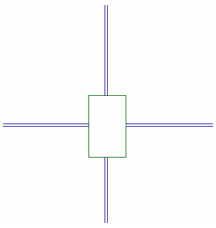Plate relations to pillars
The system determines the connection type for plate-to-pillar relations similarly than for plate-to-profile relations when it applies automatic plate beveling. See Plate relations to profiles. However there are more possible situations with plate-to-pillar relations than with plate-to-profile relations, which are described below.
The connection type is either connection to a part in plan view or connection to a part in cross-section.
The plate can have an angle to the pillar. In this case the system adjusts the plate size to prevent gaps and overlaps in the connection. See Automatic plate size adjustment.
When the plate is related to a pillar in cross-section, the connection is always considered to be a connection to a part in cross-section. The pillar body thickness should be used in the plate beveling rules (variable th_1 or th_2).
The bevel that is applied in each case is defined in plate beveling rules. See Plate beveling rules.
Plate related to lower side of pillar body
When the plate is related to the lower side of the pillar's body side, the connection is considered to be a connection to a part in plan view.

Plate connecting to the lower side of pillar body side
Note that when the plate is related to the flange of the pillar, the connection is considered to be a connection in cross-section, as is the case with regular profiles.
Plate related to duct, axes or pipe
When the plate is related to a pillar that is a duct, axes or pipe, the connection can be to any side of the pillar. The connection is considered to be a connection to a part in cross-section.

Four plates connecting to duct
-
The pillar is a duct, axes or pipe. The plate can be related to any side of the pillar.
-
The plate is related to the flange of the pillar.
In this case the flange thickness should be used in the plate beveling rules (variable th_1 or th_2).